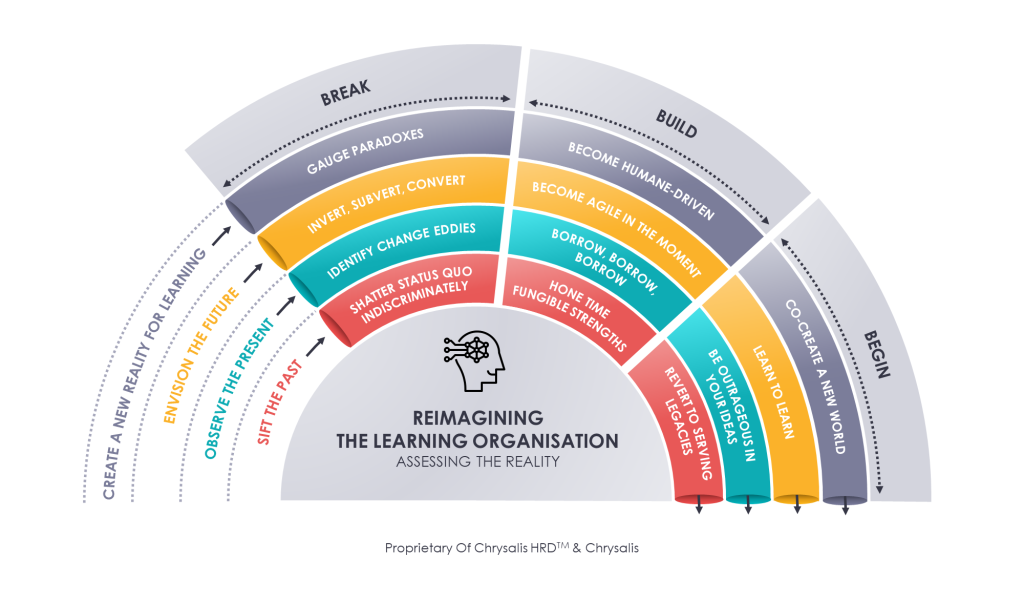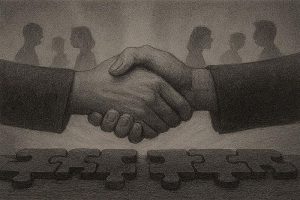The last time I wrote about this topic – I wrote about how the first step to reimagining learning was to scan the environment. When you work towards reimagining learning in your organisation, it makes imminent sense to create a blueprint for the next-generation learning approach that delivers tangible strategic outcomes.
As I have mentioned before, building capabilities to take on a world like never before, helping people pivot to roles that may not even exist today, creating agile, fluid, restorative learning within organisations while staying focussed on making it more robust from a business perspective will become the mainstay of all people professionals.
In the past few months, I have sat in silence while my mind has run circles around what the future of learning in organisations will be. For the future, what if we made learning optional – moved it away from a mandate to an invitation? How do we leverage employee data to maximize the output that drives learner experience and business results? How will learning effectiveness be measured – more and more on-the-job or will it take the form of micro KRAs that will be measured through behavioral outcomes? Will learning application be monitored through deep data analytics? In a world driven by technology can learning be well integrated into organizational goals of mental well-being or Diversity and Inclusion? Can Learning teams actually measure mental wellness or the inclusive approach of their learners? These are a few questions we should be asking ourselves while assessing the reality.
In my previous article, Reimagining the Learning Function – Scanning the Environment I talked about Scanning the Environment using the Five Influencing Forces through various lenses. After scanning the environment, it is time to assess your organisation’s reality. To do this, it is essential to Begin, Break, and Build.

When you look at a Learning function and try to reimagine it, you need to: –
- Break barriers and old ideas that no longer are relevant,
- Build new strengths, and
- Begin new legacies.
When you embark on these actions, you need to pivot your breaking, building, and beginning around the 4 action pillars. These are: –
- Sift the Past
- Observe the Present
- Look into the Future
- Create a New Reality
Step 1: Sift the Past
A good place to start reimagining learning is really the Past. In organisations today, the past is done and dusted, and the focus is really on moving on. There are however great answers in the past that can be leveraged for the future.

- The first thing to do is to Shatter status quo indiscriminately – We need to reflect and take actions and decisions that challenge the existing order of things. As people professionals, we need to question the existing ways of doing things. I have often used 5 Ws and an H to come to some strong insights about where a client’s learning function is. Developing business foresightedness will help you shatter what is being done automatically but is truly not adding value to the entire organisation.
- When you sift the past, you also focus on strengths and assets that are a part of your DNA. This will help you hone time fungible strengths. For a learning function to be reimagined, look into the past and see what will make sense in the future. When you juxtapose this with the environment that you are operating in, then you really take regular strengths and convert them into those that stand the test of time.
- When you are sifting the past, reflect on what has been working well for the organization in terms of learning – for example – the organisation has an ability to learn, there is a strong sponsorship for any learning initiative. To survive and thrive amidst disruptions, it is critical to gain comfort and revert to serving legacies. The world legacy does not always have connotations of old-school or traditionalism. Legacies act as anchors to help people, functions and organisations stay tethered in a buffeting environment.
Step 2: Observe the Present

- Our World is changing moment by moment and our customers and consumers’ needs and expectations are evolving daily. Our businesses, that are colligated between these two, are poised for change as well. Smart businesses observe the present very carefully and adapt, transform, and evolve. As a Learning function we also need to identify change eddies– those subtle changes or micro trends that appear each day that will impact each business activity. We need to make sure that while we track this in the present, we are evaluating how these will impact the organisation in the long-term. Learning functions will need to break the power of these eddies by being prepared for the waves of change.
- I remember the times when the learning function of organisations would build three-year plans. When it comes to Learning and Development, we need to become agile in the moment –be adaptable to the unexpected and uncertain as we ease into the future and be cognizant of the contradictions that await us. Learning functions will need to build this agility not just in its outcomes but also in the way it operates.
- Creating a strategy is one thing and executing a strategy is another monster altogether. Execution of a reimagined Learning function involves future-proofing your organization that puts people first, creates connective collaboration, focuses on outcomes, seeks ideas and feedback, and executes data-informed strategies. What’s critical is that we need to kickstart the strategy, in whatever small ways, but kickstart we must. Be outrageous in your ideas and try them out without fear of failure. Waiting for perfection in terms of the Learning team’s capabilities, learning infrastructure and governance will not yield quick and proactive business results. A trap that one may get into is talking more about what you would do given the opportunity – than working to create that reality.
Step 3: Envision the Future

- As a Learning function, if we need to do things differently, we must think differently. Invert, Convert, Subvert should be the mantra. We need to look at things and change the order and position of learning and learning elements to create a new perspective or ways of working. As People professionals, we need to change the nature and form of learning – accepting new needs of learners and new modalities of building capabilities in organisations. While we are doing these two, the question to ask is, are we subverting and throwing over our own mindsets and loyalties to a set way of working. An ecosystems way of thinking becomes critical – an integrated approach where people, process, content, experiences, measurement, and analytics are aligned with business strategy supported by technology.
- In transforming for the future, learning leaders should consciously avoid taking a myopic and insular approach that they and their teams alone can effectively handle large-scale transformation of the Learning function. They need to learn how to Borrow, borrow, borrow. Reimagining requires a clear-eyed perspective and perspectives are best formed when we are open to borrowing from diverse backgrounds – like literature, economics, psychology, art just to name a few. Borrowing from trends in the world helps in creating a base for quick application and can give an added boost in transforming your learning function. Learning from others and bringing in other industry best practices through external and internal experts from varied disciplines will build your transformation journey and make it resilient.
- Technology is changing at a pace that an average person cannot even comprehend. The sheer speed is overwhelming. In this environment, it is comfortable to hold on to what we already know. The challenge to all People professionals who are reimagining their learning functions is to understand that nothing is carved in stone, and we will need to Learn to Learn. The strength that we should develop is to not hold anything as sacred and to evaluate the usefulness of all learning elements with an unbiased view – be it ideas or ways of working. In envisioning the future, the process of learning, unlearning, and relearning will be accelerated far more than ever before. And we need to begin to track the development of this muscle.
Step 4: Create a new Reality in Learning

- Science and technology advancements have intensified. Organisations today are adapting to and adopting new technologies. While things are becoming more convenient, life is becoming more complex. In this complexity, work is becoming effortless, the work structure is becoming more complicated. Here, while human interactions are becoming easier, human connections are becoming more surficial. The Age of Paradoxes is here to stay. People professionals must commit to Gauge the Paradoxes and simplify the complexity at the workplace. Learning Functions should no longer just equip people for work but also help them navigate through the complexities of life. Learning functions can break these paradoxes and make the workplace of the future, a space where people can be the best version of themselves.
- In the future will our jobs become reflective of a dystopian society, or can they help us become better human beings? The learning function of organisations will evolve from making people good at their jobs to becoming more evolved world citizens. The journey to become Humane-driven and not Human driven will be the focus of the learning functions of the future. Acceptance, humility, kindness, compassion, and a sense of stewardship of the world we live in will need to be inculcated in the workforce. With Artificial Intelligence coming into every aspect of our work, Learning functions of the future will become champions for creating thriving humane communities in organisations.
- In envisioning the future, People Professionals and Learning functions have the golden opportunity to Co-create a new world. Making people find joy at work, friends in teammates, mentors in inspiring leaders and a sense of purpose to better the world that we live in, can become the overarching themes of Learning functions. Gone will be the tag of just being an enabling function – Learning functions will be seen as the architects of a new, enhanced humane community that works together for a better world.
To know more about how Chrysalis can help you reimagine your Learning function, visit us at http://chrysalis.in


